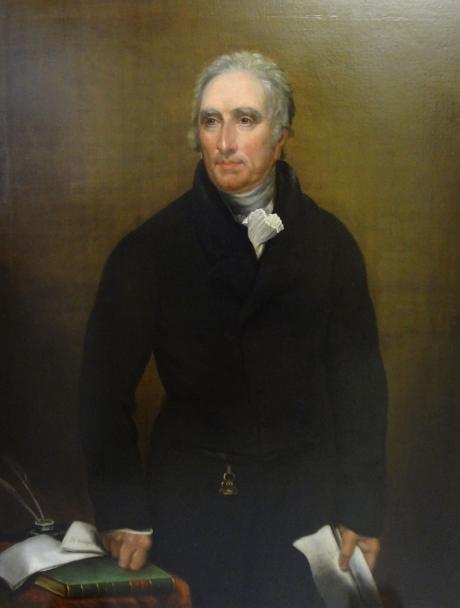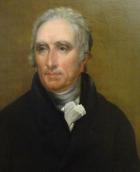Sitters hand resting on a document bearing his name and a book entitled "Agricultural Report", the document held in his left hand inscribed " Elected for the county of Cumbd and City of Carlisle March 1820".
Engraved and published by Charles Turner, Nov, 1820
Curwen, John Christian (1756–1828), agriculturist and politician, was born on 12 July 1756 at Ewanrigg, Dearham, Cumberland, the eldest to survive infancy of the sons of John Christian of Ewanrigg, and his wife, Jane, eldest daughter of Eldred Curwen of Workington Hall, Cumberland. He was educated at Peterhouse, Cambridge; he left the university without a degree about 1774. On 10 September 1775 he married Margaret, daughter of John Taubman of Castletown, Isle of Man. She died in 1778, leaving a son, also John Christian. He remarried on 5 October 1782 at Edinburgh; his second wife was his cousin Isabella, daughter of his uncle and guardian, Henry Curwen of Workington. She brought him £5000 p.a. and her family's support in the career in Cumberland politics which he subsequently began. They had five sons and three daughters. He took on the surname Curwen in 1790 [see Curwen family (per. c.1500–c.1725)]. A whig in politics, Curwen was returned to the House of Commons for Carlisle in 1786, was defeated for that constituency in 1790, regained it in 1791, held it until 1812, and held it again from 1816 to 1820. He then represented Cumberland from 1820 until his death. He was an active parliamentarian who supported Catholic emancipation, parliamentary reform, and the repeal of the corn laws. To emphasize his concern for his constituents he once appeared in the House of Commons dressed like a Cumberland labourer and carrying a loaf and a cheese under his arms. In 1796 he made an ineffectual bid to reform and virtually abolish the game laws. Politically, he is best known for Curwen's Act, which was passed in 1809. The act was one of the very few significant reforms of the pre-1832 system; it attempted to reduce the sale of seats and the number of government placemen in the Commons, but was less successful than contemporaries initially feared. Curwen's interest in agriculture probably dated from a long journey through Europe following the death of his first wife in 1778. He was a friend of Arthur Young and knew the leaders of progressive agricultural opinion in Scotland. In Cumberland he embarked on an improvement programme on his estates at Workington Hall. In 1805 he inaugurated the Workington Agricultural Society, which had a profound impact on local agriculture in the first half of the nineteenth century. In 1807 he received the gold medal of the Society of Arts, Commerce, and Manufactures, for his agricultural innovations. Many of his ideas were published in Hints on Agricultural Subjects (1809), and his views on Ireland, where he spent time between 1813 and 1816, appeared in Observations on the state of Ireland, principally directed to its agriculture and rural population (1818). Part, at least, of his motive in studying agriculture was to improve the lot of the labouring poor. To the latter end he was also responsible for establishing a savings bank at Workington, and for various friendly societies. Curwen's estates lay on the west Cumberland coalfield, and he took a particular interest in the collieries inherited from his father and his second wife, as well as in others which he purchased and leased in the area. However, he was hit by the trade depression after the Napoleonic wars, and by the 1820s Workington colliery was in decline. Increasing costs and declining profits forced him to borrow, and from 1819 until 1827 Curwen owed more than £120,000. Consequently he was not able to invest in improved mining techniques in the later years of his life. Curwen was sheriff of Cumberland in 1784–5 and was active in the militia. He died at Workington Hall on 11 December 1828.
John James Halls (1776–1853), painter, was born at Romford, Essex, and baptized there on 16 May 1776, the eldest of the six children of James Halls and his wife, Amelia Garnett (d. 1813). In the 1780s the family moved to Colchester. Halls, says Farington, ‘practised drawing and painting from a Child’, and was taught by ‘Sturt of Colchester’ (Farington, Diary, 4.1216). Aged fifteen, he exhibited a landscape at the Royal Academy. At the end of 1798 he settled as a professional artist in London. In September 1802 Halls went to Paris with Henry Fuseli RA and Joseph Farington RA for six weeks, to study the collections brought together by Napoleon. Fuseli remarked of him that he ‘sees, observes, says little, laughs more’ (J. Knowles, ed., The Life and Writings of Henry Fuseli, 3 vols., 1831, 1.253). Between 1798 and 1827, he exhibited annually at the academy, less frequently at the British Institution, mainly portraits, but with the occasional history painting, such as Fingal Assaulting the Spirit of Loda (1798), Lot's Wife (1802), Hero and Leander (1808), and Danae (1811). Christ Raising the Daughter of Jairus (Museum Resource Centre, Colchester Museums) won a premium of 200 guineas when it was exhibited at the British Institution in 1813, the committee being ‘all struck with it as one of the greatest efforts that has been made in England, not for a young artist, but for any artist’ (Halls, 1.369). Perhaps his most successful effort was A Witch—‘but in a Sieve I'll thither Sail’—from Macbeth, which was engraved in mezzotint in 1807 by Charles Turner, as was also his Charles Kean as Richard III (exh. RA, 1815). His portrait of Lord Denman (exh. RA, 1819) hangs in the National Portrait Gallery, London. On 2 December 1819 Halls married Maria Anne (bap. 1795, d. 1877), daughter of Baker John Sellon, serjeant-at-law.
In 1813 Halls completed a stained glass window for Lichfield Cathedral, a commission obtained through his close friend the famous explorer in Abyssinia and British consul in Egypt, Henry Salt FRS. In 1834, in fulfilment of a youthful pact with Salt that the survivor should write the other's biography, he published The Life and Correspondence of Henry Salt. He had already, in 1831, completed and published Salt's unfinished editing of The Life and Adventures of Nathaniel Pearce. He had moved to Hampstead in the 1830s, and he died there at his home, Ivy Cottage, Lower Heath, on 22 July 1853, of a long-standing kidney disease.
L. H. Cust, rev. Peta Rée DNB



